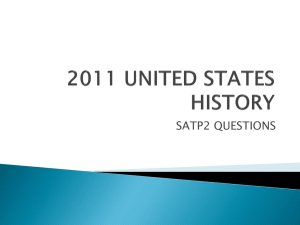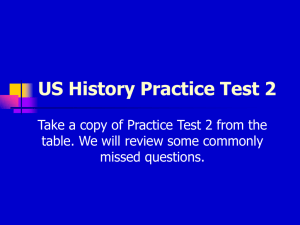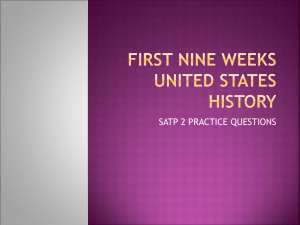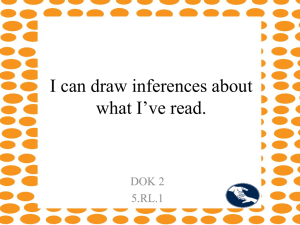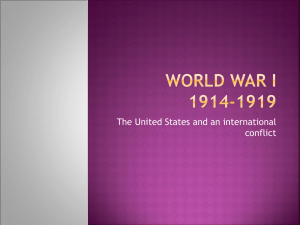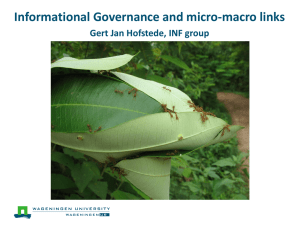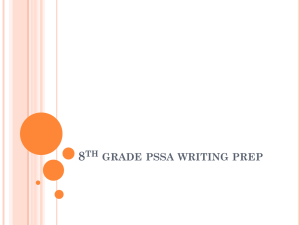Fourth Grade I Can Posters Border
advertisement
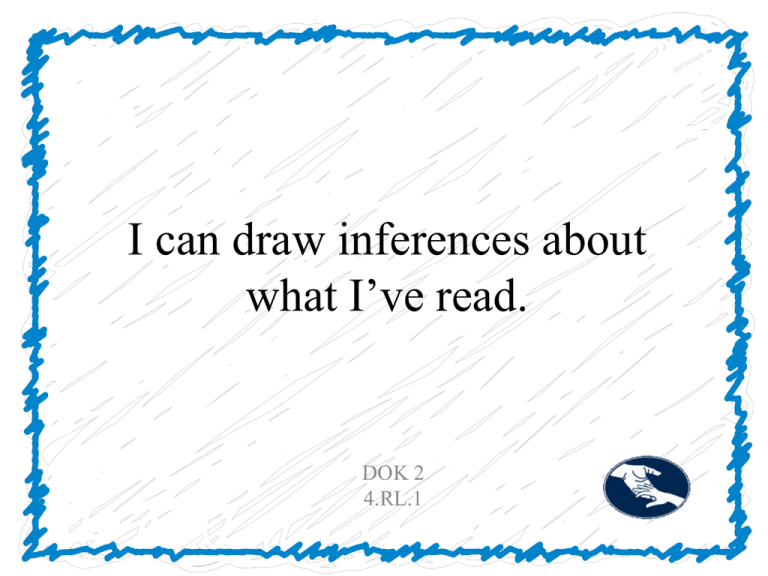
I can draw inferences about what I’ve read. DOK 2 4.RL.1 I can support my inferences with details. DOK 3 4.RL.1 I can give details and examples from the text. DOK 1 4.RL.1 I can explain what I read. DOK 1 4.RL.1 I can explain the theme of a story, drama, or poem with details. DOK 2 4.RL.2 I can summarize the text. DOK 3 4.RL.2 I can describe a character in depth. DOK 2 4.RL.3 I can describe the setting of the story. DOK 1 4.RL.3 I can explain events in a story with evidence to support it. DOK 3 4.RL.3 I can determine the meaning of words and phrases, when reading about characters in a myth, by using clues found in the story. DOK 0 4.RL.4 I can tell my teacher or a friend about the different parts of poems and plays that I read. DOK 1 4.RL.5 I can describe the purpose of the poem or plays that I read. DOK 2 4.RL.5 I can compare poems and plays to each other. DOK 3 4.RL.5 I can compare and contrast the point of view of the stories I read. DOK 3 4.RL.6 I can tell the difference between first and thirdperson. DOK 1 4.RL.6 I can make connections between different types of texts. DOK 3 4.RL.7 I can describe the purpose of the story. DOK 2 4.RL.7 I can draw conclusions, from the connections I made, between the different stories that I read. DOK 4 4.RL.7 DOK 4.RL.8 I can compare and contrast stories and myths from different cultures. DOK 3 4.RL.9 I can discuss how themes and events are similar from one story to another. DOK 4 4.RL.9 I can read stories at my grade level. DOK 1 4.RL.10 I can identify the main idea of the story I read. DOK 2 4.RL.10 I can describe what I read. DOK 1 4.RI.1 I can use the details and examples in the text to explain the text and infer meaning. DOK 0 4.RI.1 I can explain the main idea of the text. DOK 1 4.RI.2 I can explain how the main idea is supported by key details. DOK 2 4.RI.2 I can summarize the text. DOK 3 4.RI.2 I can use specific events and ideas from the informational reading that I do to explain what happened and why. DOK 0 4.RI.3 I can determine the meaning of words when I read nonfiction grade level texts by using context clues. DOK 0 4.RI.4 I can connect old ideas with new concepts when reading informational text. DOK 3 4.RI.4 I can describe the sequence of events in informational text. DOK 1 4.RI.5 I can describe the cause and effect in informational text. DOK 2 4.RI.5 I can analyze the problem and solution in informational text. DOK 3 4.RI.5 I can compare and contrast a firsthand account and a secondhand account of the same historical event or topic. DOK 4 4.RI.6 I can describe the differences of firsthand and secondhand accounts. DOK 3 4.RI.6 I can interpret information from charts, graphs, timelines, animations, etc. DOK 2 4.RI.7 DOK 3 4.RI.7 I can explain how visual information helps me understand the text. DOK 3 4.RI.7 I can determine the main idea of the text. DOK 2 4.RI.8 I can explain the reasons and evidence that the author uses to support main ideas in the text. DOK 3 4.RI.8 I can use more than one text to research a topic. DOK 3 4.RI.9 I can write or speak about the subject I research. DOK 4 4.RI.9 I can read and comprehend informational text. DOK 0 4.RI.10 I can use word decoding strategies to read unfamiliar words. DOK 1 4.RF.3 I can read with purpose and understanding. DOK 0 4.RF.4a I can read prose and poetry aloud with accuracy, rate and expression. DOK 0 4.RF.4b I can use context to know if I am reading accurately and can selfcorrect when necessary. DOK 0 4.RF.4c I can include my opinion in the introduction of the topic when writing an opinion piece. DOK 3 4.W.1 I can organize my ideas when writing an opinion piece. DOK 2 4.W.1a I can support my opinion with facts and details when writing an opinion piece. DOK 3 4.W.1b I can link opinion and reasons when writing. DOK 4 4.W.1c I can write a concluding paragraph to support my opinion when writing. DOK 4 4.W.1d I can organize information in paragraphs. DOK 2 4.W.2a I can introduce an informational topic clearly. DOK 2 4.W.2a I can include informational text features and multimedia to help my reader understand my message. DOK 4 4.W.2a I can use facts, definitions, details, quotations and examples to develop an informational topic. DOK 3 4.W.2b I can make my writing flow smoothly when writing an informational piece by using transition words. DOK 2 4.W.2c I can use specific vocabulary to better inform my reader. DOK 2 4.W.2d I can write a concluding statement or paragraph to support my topic when writing an informational piece. DOK 4 4.W.2e I can introduce my reader to the topic by clearly identifying the characters, setting, plot, narrator, sensory details, and sequence of events. DOK 2 4.W.3a I can describe experiences and events through character dialogue helping my reader to better understand. DOK 3 4.W.3b I can use a variety of transitional words and phrases to organize the sequence of events. DOK 2 4.W.3c I can use specific words or phrases and sensory details to describe experiences and events in narrative writing. DOK 3 4.W.3d I can write a clear conclusion when writing a narrative piece. DOK 4 4.W.3e I can produce clear and organized writing that includes the appropriate task and purpose for the appropriate audience. DOK 0 4.W.4 I can develop and strengthen my writing by planning, revising, and editing it with guidance from peers and adults. DOK 0 4.W.5 I can use technology to produce and publish my writing. DOK 1 4.W.6 I can use technology to communicate with others. DOK 2 4.W.6 I can type a minimum of one page in a single sitting. DOK 1 4.W.6 I can research and investigate a topic to gain knowledge and understanding. DOK 0 4.W.7 I can recall and gather important information from print and digital sources. DOK 0 4.W.8 I can take notes and organize information and list the sources that I have used. DOK 0 4.W.8 I can gather information from literary or informational texts to support my thoughts, reflection, and research on my topic. DOK 0 4.W.9 I can write for extended periods of time for many tasks, purposes, and audiences. DOK 0 4.W.10 I can work cooperatively with peers. DOK 1 4.SL.1 I can come to discussions being prepared and ready to explore ideas and discussions. DOK 2 4.SL.1a I can follow the rules and carry out my assigned role. DOK 1 4.SL.1b I can ask questions and answer questions in a discussion. DOK 3 4.SL.1c I can review the key ideas that were expressed. DOK 4 4.SL.1d I can summarize text that is presented or read orally. DOK 0 4.SL.2 I can identify the reasons and evidence presented on a topic. I can also summarize it. DOK 0 4.SL.3 I can present on a topic in an organized manner, using details and examples to support my topic. DOK 0 4.SL.4 I can speak clearly at an understandable pace while presenting my information. DOK 1 4.SL.4 I can use multimedia and visuals in presentations to help support my topics, my main idea, or theme. DOK 0 4.SL.5 I can choose the appropriate way to express my thoughts during presentations. DOK 0 4.SL.6 I can use relative pronouns to join clauses together. DOK 1 4.L.1 I can use relative pronouns when referring to something or someone that has been mentioned. DOK 2 4.L.1a I can use correct verb tense when speaking and writing. DOK 1 4.L.1b I can use verb phrases correctly. DOK 1 4.L.1c I can correctly use adjectives when describing a noun. DOK 2 4.L.1d I can use prepositional phrases to add details and clarity when I speak or in my writing. DOK 2 4.L.1e I can create complete sentences and fix sentences that may be incomplete or run-on. DOK 2 4.L.1f I can correctly use homophones when I speak and in my writing. DOK 1 4.L.1g I can correctly use capitalization rules when writing. DOK 1 4.L.2a I can correctly use commas and quotation marks to show when someone is talking. DOK 1 4.L.2b I can correctly use a comma before conjunctions to bring two related thoughts together. DOK 1 4.L.2c I can spell grade level words correctly and use a spelling reference when needed. DOK 1 4.L.2d I can choose appropriate words and phrases to express my ideas clearly. DOK 2 4.L.3a I can choose punctuation to help me effectively express my ideas. DOK 2 4.L.3b I can decide when I need to communicate in a more formal manner and when more casual communication, with friends or in a small group, is appropriate. DOK 2 4.L.3c I can use word strategies to understand the meaning of words or phrases when I read. DOK 1 4.L.4a I can use Greek and Latin affixes and roots to help me create meaning when I read. DOK 2 4.L.4b I can use reference materials to find the pronunciation and meaning of key words and phrases. DOK 3 4.L.4c I can identify and explain the meaning of similes and metaphors. DOK 0 4.L.5a I can recognize and explain the meaning of idioms, adages and proverbs. DOK 2 4.L.5b I can explain the meaning of words by relating them to their synonyms and antonyms. DOK 3 4.L.5c I can build my vocabulary of grade-level and subject words. DOK 2 4.L.6 I can use these words to communicate descriptively about particular topics. DOK 1 4.L.6
